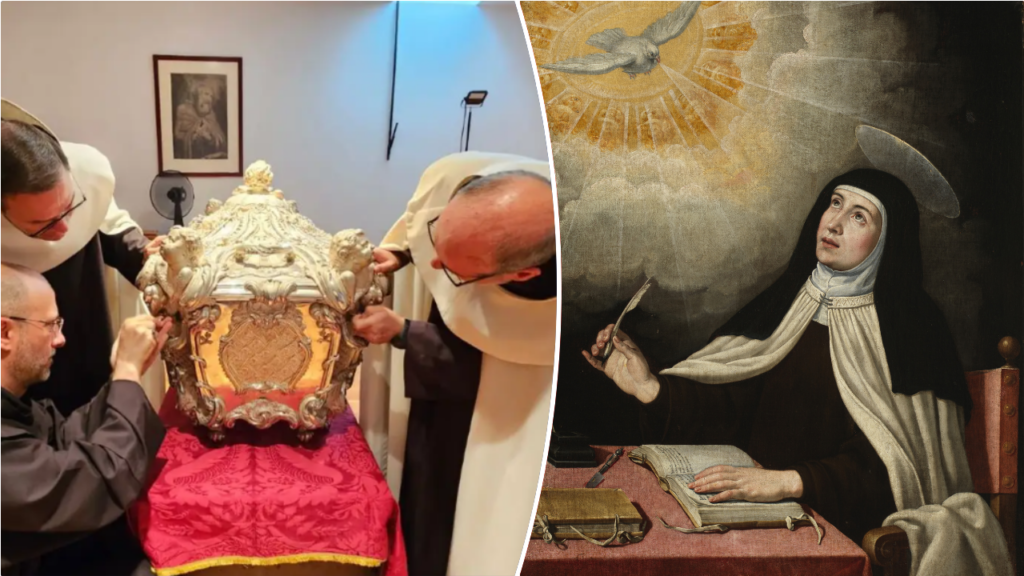In a remarkable revelation from the ecclesiastical world, researchers have begun to unveil details regarding the impressive preservation of St. Teresa of Jesus, a renowned Catholic saint, whose remains were discovered to be remarkably “incorrupt” last year. St. Teresa of Avila, a foundational figure in the Discalced Carmelite order, died in the year 1582. Her tomb in Alba de Tormes, Spain, was opened for the first time in over a century on September 23, 2022, revealing astonishing findings that have captivated both scholars and the general public.
The announcement from the Diocese of Avila regarding the opening of St. Teresa’s sarcophagus was met with great anticipation, particularly among those fascinated by historical and religious phenomena. Father Marco Chiesa, who was part of the initiative, noted the remarkable similarity between the facial and foot features of the saint as observed in 1914. He emphasized that while the outer layer of St. Teresa’s skin is mummified and lacks color, the distinct contours of her face remain remarkably discernible. “It looks good,” he stated, referring to the condition of her visage, which was described as almost clear by expert observers examining her remains.
In a detailed report provided to the Discalced Carmelites in March, following a thorough 53-page analysis of the relics, it was revealed that St. Teresa’s body, left arm, and heart were integral components of the findings. Esteemed Italian anthropology professor Luigi Capasso, who led the research, characterized St. Teresa’s remains as “perfectly preserved.” His analysis uncovered that specific parts of her body, including the right foot, left hand, heart, and left arm, exhibited a fascinating state of preservation, featuring intact skin, subcutaneous tissues, and well-maintained muscles, devoid of any degradation.
Further inspection led to the discovery of preserved strands of her once-brown hair, one intact eyeball with a dark iris, and even nasal tissues that had remarkably endured the test of time. Capasso poignantly remarked, “This preservation, more than 400 years after her death, transmits a serenity that reflects how she faced her departure,” emphasizing the spiritual significance that such remain conditions might possess.
Among other intriguing aspects of her preservation, the saint’s forehead still displays the imprint left by her 16th-century Carmelite headdress. The environmental factors of St. Teresa’s final resting place greatly contributed to this phenomenon; the dry atmosphere within her tomb has been identified as a crucial factor in preventing the rapid decomposition typically caused by excessive moisture.
Capasso also mentioned that his team is taking proactive measures to prevent any future deterioration of the relics, safeguarding them against both mechanical and biological degradation. “It is a truly unique natural phenomenon,” he declared, underscoring the exceptional nature of the findings.
These latest observations come after previous research revealed insights into St. Teresa’s physical condition leading up to her death. The Carmelites had released initial findings following the opening of her tomb last summer, which allowed experts to gauge her health challenges in the years before her passing. Father Chiesa elaborated that the saint experienced significant mobility difficulties, describing her struggles with walking due to ailments. Intriguingly, while analyzing one of her foot relics located in Rome, researchers noted the presence of calcareous spines, which would have made ambulation exceedingly difficult.
Despite these challenges, St. Teresa demonstrated an extraordinary tenacity, continuing to make strides towards her goals until her final moments. Her journey to Alba de Tormes and the determination she exhibited in her struggles exemplify not just a personal story but also the deep faith that surrounded her existence and legacy.
As researchers continue to study St. Teresa’s remarkably preserved remains, these findings not only contribute to our understanding of historical and religious contexts but also ignite a broader reflection on the intersection of faith, science, and humanity’s enduring quest for the miraculous. The preservation of St. Teresa stands as a testament to her life, faith, and the intricate ways in which historical figures can continue to inspire and evoke curiosity long after their physical departure from this world.











